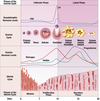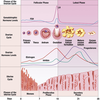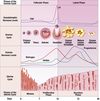Contraception and the Menstraul Cycle Flashcards
What are examples of barrier methods of contraception?
- Male condoms
- Female condoms
- Diaphragm
What are benefits of male condoms?
- Only used during intercourse
- Reduces STI transmission
- Rarely side effects from use

What are the limitations of male condoms?
- Can break, split or tear during use
- Can interrupt intercourse to put a male condom on
- Need to know the correct technique for using condoms
- Some patients are allergic to latex condoms

What is the effectiveness of condoms from typical use?
82%

What are the benefits of female condom use?
- Only used during intercourse
- Reduces STI transmission
- Rarely side effects from use

What are limitations to female condom use?
- Can break, split or tear during use
- May interrupt intercourse to put the female condom in place
- Need to know the correct technique for using condoms
- Female condoms are not as widely available as male condoms

What is the diaphragm form of contraception?
Silicone cup which is placed over the cervix as a barrier to sperm

What are the benefits of diaphragm contraception?
- Only used during intercourse
- Can be put in place in advance of intercourse
- Rarely side effects from use

What are the limitations of a diaphragm?
- Can break, split or tear during use
- May interrupt intercourse to put the diaphragm in
- Patients need to know the correct technique for using a diaphragm
- Does not protect against STIs

What is the effectiveness of the female condom?
79%

What is the combined contraceptive?
Contain forms of both oestrogen and progesterone
What is the mechanism of of action of COCP?
They work by mimicking the luteal phase of the menstrual cycle, leading to inhibition of the hypothalamic-pituitary-gonadal axis. This prevents the release of LH and FSH needed for ovulation.
Combined contraceptives further reduce the risk of pregnancy by thickening the cervical mucus to prevent sperm passage and by thinning the endometrium to reduce the chance of implantation.
How often is the oral contraceptive pill taken?
21 days followed by a 7 day break
What occurs within the pill-free week when a woman is using the COCP?
Withdrawal bleed
What are examples of combined oral contraceptives?
- COCP
- Contraceptive patches
- Vaginal rings
What are the benefits of the COCP?
- Does not interrupt intercourse
- Can be stopped at short notice if not tolerated
- May make periods more regular, lighter and less painful
- May reduce the risk of ovarian, endometrial and bowel cancer
- May have therapeutic benefits in gynaecological disorders including endometriosis and menorrhagia

What are limitations of COCP?
- Effectiveness reduced if pill is forgotten
- Side effects may include headaches, nausea, breast tenderness and mood swings
- Vomiting and diarrhoea may affect effectiveness
- Certain drugs including some antibiotics and anti-epileptic drugs may affect effectiveness
- Increases the risk of VTE and stroke
- Potentially increases the risk of breast cancer while using the COCP
- Does not protect from STIs

What are contraindicaitons for the use of combined contraceptive options?
- Migraine with aura
- Current breast cancer
-
High VTE risk factors, such as:
- Atrial fibrillation
- SLE positive for antiphospholipid antibodies
- Age over 35 years old and smoking at least 15 cigarettes daily
- History of stroke
- History of VTE
- Major surgery with prolonged immobilisation
- Known thrombogenic mutations
- Complicated valvular or congenital heart disease
-
Other cardiovascular risk factors such as:
- Hypertension: >160mmHg / >100mmHg
- History of ischaemic heart disease
- Severe liver disease
What part of combined contraceptive increases risk of VTE?
Oestrogen
How do contraceptive patches work?
Contraceptive patches deliver their oestrogen and progesterone through the skin and inhibit ovulation as above. They are approximately 4x4cm in size and can be applied to any skin except the breast, where the tissue is oestrogen sensitive
How are contraceptive patches used?
One patch is applied for 7 days and then immediately changed for a new patch. 3 patches should be worn for 21 days in total and then there should be 7 days without a patch when they have a period-like withdrawal bleed. The next 21 days of patches should be started after exactly 7 days.
What are benefits of contraceptive patches?
- Do not need to remember daily like the pill
- Does not interrupt intercourse
- Can be stopped at short notice if not tolerated
- May make periods more regular, lighter and less painful
- May reduce the risk of ovarian, endometrial and bowel cancer
- Vomiting and diarrhoea do not affect effectiveness unlike the pill

What are limitations of contraceptive patches?
- Protection from pregnancy may be affected if they forget to change the patch or if it falls off
- Side effects may include headaches, nausea, breast tenderness and mood swings
- Certain drugs may affect effectiveness including some anti-epileptic drugs
- Increases the risk of VTE and stroke
- Potentially increases the risk of breast cancer while using the patch
- Does not protect from STIs

How does the vaginal ring work?
The contraceptive vaginal ring (also known as the NuvaRing®) is a small plastic ring that is placed high in the vagina and secretes oestrogen and progesterone to prevent ovulation.
How is a vaginal ring used?
The ring is inserted into the vagina for 21 days and then removed for 7 days before the next ring is put in.
What are the benefits of vaginal rings?
- Do not need to remember daily like the pill
- Does not interrupt intercourse
- Can be stopped at short notice if not tolerated
- May make periods more regular, lighter and less painful
- May reduce the risk of ovarian, endometrial and bowel cancer
- Vomiting and diarrhoea do not affect effectiveness unlike the pill

What are limitations of the vaginal ring?
- Side effects may include headaches, nausea, breast tenderness and mood swings
- Certain drugs may affect protection including some anti-epileptic drugs
- Increases the risk of VTE and stroke
- Potentially increases the risk of breast cancer while using the ring
- Does not protect from STIs

How does progesterone only pill work?
- Desogestrel POP - inhibiting ovulation, thickens cervical mucus and thinning the endometrium.
- Norethisterone and levonorgestrel POPs - thickens cervical mucus and thinning the endometrium.
What are examples of progesterone-only contraceptives?
- POP
- Contraceptive injection
- Progesterone implant
What are benefits of POP?
- Suitable for patients where oestrogen is contraindicated or those who are intolerant to oestrogen
- Taken without breaks so don’t have to remember to start and stop pills
- Does not interrupt intercourse
- Can be stopped at short notice if not tolerated
How would you take a Progesterone only pill?
Needs to be taken every day
- Pills with etynodiol/norethistrone/levonogestrol - have a 3hr window
- Desogestrel POP - 12h window
What are benefits of using POP?
- Suitable for patients where oestrogen is contraindicated or those who are intolerant to oestrogen
- Taken without breaks so don’t have to remember to start and stop pills
- Does not interrupt intercourse
- Can be stopped at short notice if not tolerated

What are limitations of POP?
- Protection from pregnancy affected if pill is forgotten
- May cause irregular bleeding, amenorrhoea or more frequent bleeding
- Vomiting and diarrhoea may affect protection
- Certain drugs including some antibiotics may affect effectiveness
- Does not protect from STIs

What are contraindications for PO contraceptive use?
- Current breast cancer
- Trophoblastic disease
- Liver disease - acute hepatitis, decompensated cirrhosis
- Migraine with aura
- IHD
- Stroke/TIA
- SLE with antiphospholipid antibodies
- Undiagnosed vaginal bleeding
What is the DepotProvera injection?
Injection containing progesterone only carried out every 12 weeks. It is typically administered intramuscularly into the buttocks
How does the DepoProvera injection work?
It is typically administered intramuscularly into the buttocks. The systemic progesterone inhibits ovulation, thickens the cervical mucus and thins the endometrium.
What are benefits of DepoProvera?
- Suitable for patients where oestrogen is contraindicated or those who are intolerant to oestrogen
- Do not need to remember to take a pill daily
- Does not interrupt intercourse
- Reduced risk of endometrial cancer, ectopic pregnancy, sickle cell crises
- May help menorrhagia











